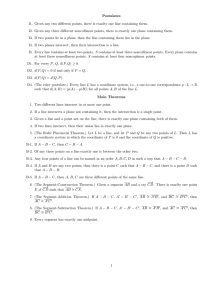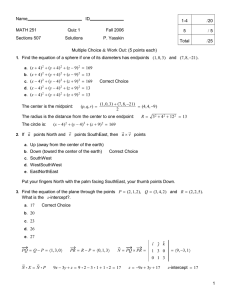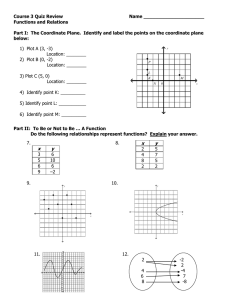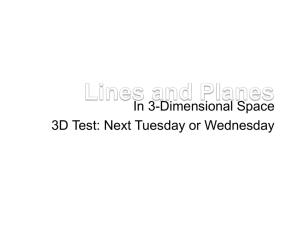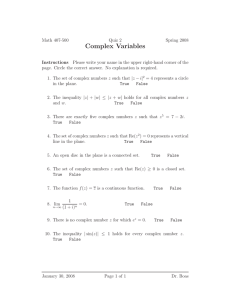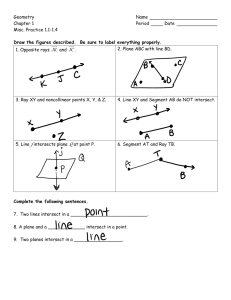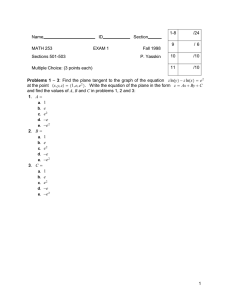Postulates I1 Given any two different points, there is exaclty one... I2 Given any three different noncollinear points, there is exactly...
advertisement
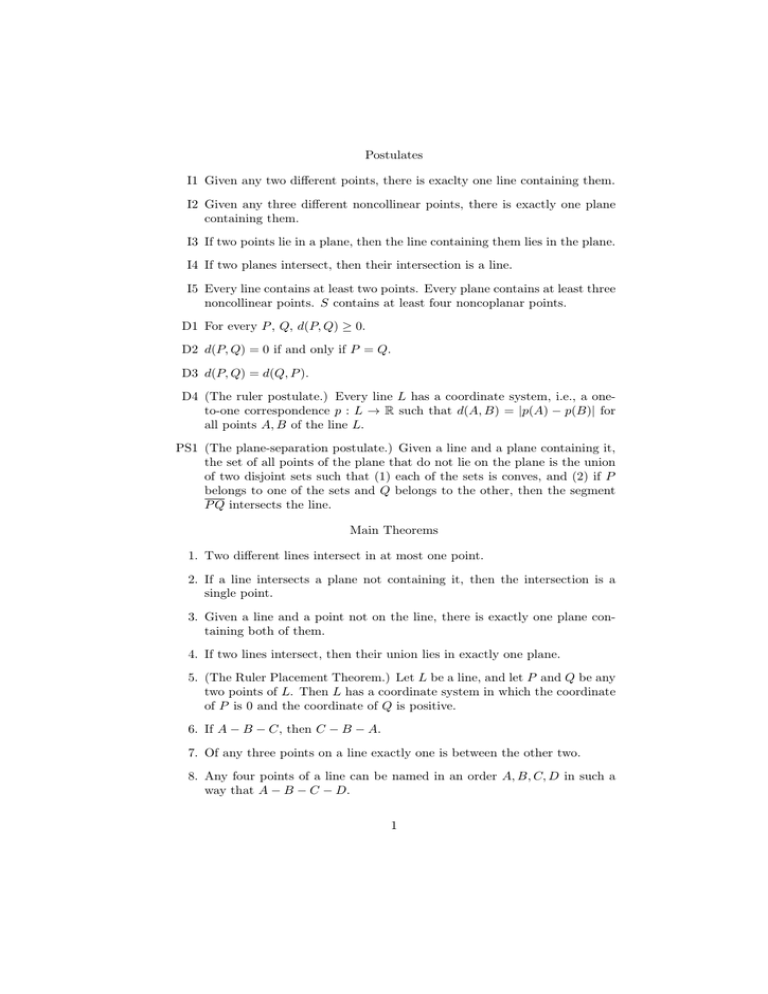
Postulates I1 Given any two different points, there is exaclty one line containing them. I2 Given any three different noncollinear points, there is exactly one plane containing them. I3 If two points lie in a plane, then the line containing them lies in the plane. I4 If two planes intersect, then their intersection is a line. I5 Every line contains at least two points. Every plane contains at least three noncollinear points. S contains at least four noncoplanar points. D1 For every P , Q, d(P, Q) ≥ 0. D2 d(P, Q) = 0 if and only if P = Q. D3 d(P, Q) = d(Q, P ). D4 (The ruler postulate.) Every line L has a coordinate system, i.e., a oneto-one correspondence p : L → R such that d(A, B) = |p(A) − p(B)| for all points A, B of the line L. PS1 (The plane-separation postulate.) Given a line and a plane containing it, the set of all points of the plane that do not lie on the plane is the union of two disjoint sets such that (1) each of the sets is conves, and (2) if P belongs to one of the sets and Q belongs to the other, then the segment P Q intersects the line. Main Theorems 1. Two different lines intersect in at most one point. 2. If a line intersects a plane not containing it, then the intersection is a single point. 3. Given a line and a point not on the line, there is exactly one plane containing both of them. 4. If two lines intersect, then their union lies in exactly one plane. 5. (The Ruler Placement Theorem.) Let L be a line, and let P and Q be any two points of L. Then L has a coordinate system in which the coordinate of P is 0 and the coordinate of Q is positive. 6. If A − B − C, then C − B − A. 7. Of any three points on a line exactly one is between the other two. 8. Any four points of a line can be named in an order A, B, C, D in such a way that A − B − C − D. 1 9. If A and B are any two points, then there is a point C such that A−B −C, and there is a point D such that A − D − B. 10. If A − B − C, then A, B, C are three different points. 11. (The Segment-Construction Theorem.) Given a segment AB and a ray −−→ −−→ CD. There is exaclty one point E of CD such that AB ∼ = CE. 12. (The Segment-Addition Theorem.) If A−B −C, A0 −B 0 −C 0 , AB ∼ = A0 B 0 , 0 0 0 0 ∼ ∼ and BC = B C , then AC = A C . 13. (The Segment-Subtraction Theorem.) If A − B − C, A0 − B 0 − C 0 , AB ∼ = A0 B 0 , and AC ∼ = A0 C 0 , then BC ∼ = B0C 0. 14. (The postulate of Pasch.) Given a triangle 4ABC, and a line L in the same plane. If L contains a point E, between A and C, then L intersects either AB or BC. 15. If P and Q are on opposite sides of the line L, and Q and T are on opposite sides of L, then P and T are on the same side of L. 16. If P and Q are on opposite sides of the line L, and Q and T are on the same side of L, then P and T are on opposite sides of L. 17. Given a line, and a ray which has its end point on the line but does not line on the line. Then all points of the ray, except for the end point are on the same side of the line. 18. Every side of a triangle lies, except for its end points, in the interior of the opposite angle. −→ 19. If F is the inetrior of ∠BAC, then AF − A lies in the interior of ∠BAC. 20. Let L be a line, let A and F be two points of L, and let B and G be points −−→ −→ on opposite sides of L. Then F B does not intersect AG. −−→ 21. (The Crossbar Theorem.) If D is in the interior of 4ABC then AD intersects BC in a point between B and C. 2
